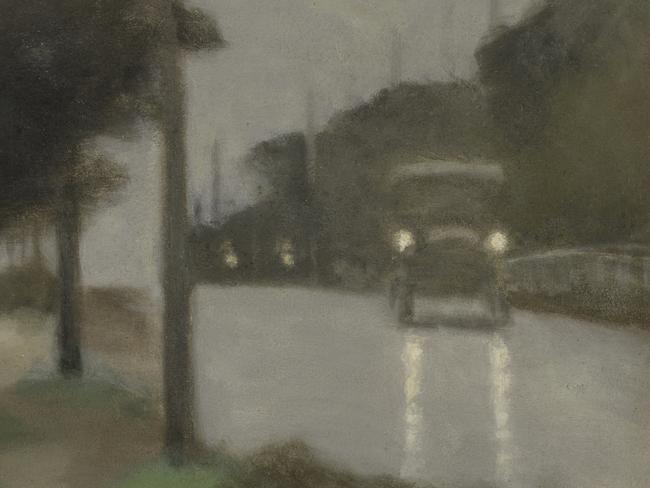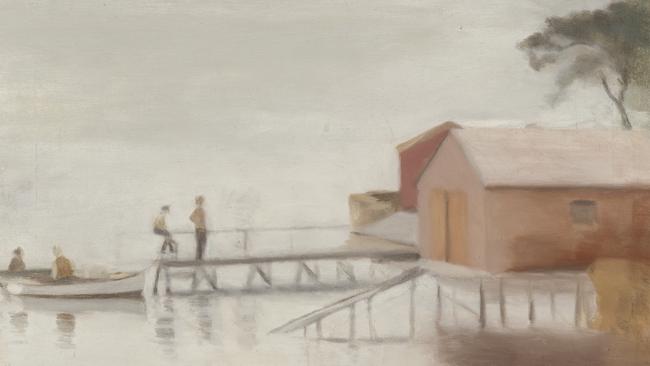Past and present exist side-by-side in Clarice Beckett exhibition
Australian art curator Tracey Lock says a retrospective of Clarice Beckett’s work provides a timely antidote to our new world order.

Adelaide Festival
Don't miss out on the headlines from Adelaide Festival. Followed categories will be added to My News.
It was Clarice Beckett’s passion for and complete immersion in capturing the moment in paint that also led to her premature death and almost consigned her art to obscurity.
After painting the sea off her Melbourne beachside suburb of Beaumaris during a storm in 1935, the Beckett became ill and died four days later in hospital, aged just 48.
“Being so totally absorbed actually led to her demise, because she became soaking wet,” says Tracey Lock, curator of a new Art Gallery of South Australia survey exhibition which is the largest ever mounted of Beckett’s work.
“She came down with double pneumonia and passed away.”

The exhibition, Clarice Beckett: The Present Moment, is part of this year’s Adelaide Festival and also a passion project for Lock, AGSA’s curator of Australian art.
It was the first state gallery to acquire one of Beckett’s paintings in 1979, after the National Gallery in Canberra had purchased eight of her works a few years earlier.
“The exhibition is going to be a really timely antidote to our new world order,” Lock says.
“There is absolutely a deep humanity in her work. I think visitors will find journeying through the exhibition a replenishing experience, a nourishing experience and a real tonic for the soul.
“Her work is well known for its emotive power … many of the works ache with feeling, but there is certainly a sense of stillness and tranquillity.”
There is also a sense of isolation in many of Beckett’s tonalist paintings, as if she is detached from the scene as an observer, rather than a participant in it.
“A lot of her paintings evoke a sense of movement, and also sound, but they also evoke a sense of spatial distance,” Lock says.
“You feel like you are passing through the frame and into the picture itself. It’s as if you are walking around with her.”

To build upon that sense, Lock visited many of the scenes depicted by Beckett in Beaumaris and neighbouring Mentone with former Melbourne gallery owner Rosalind Hollinrake, who rediscovered the artist in the 1960s and whose private collection forms the core of the new exhibition.
“The family moved to Beaumaris in 1919 and built quite a substantial family home. It’s that point from which Clarice journeyed every single day on foot to go and paint,” Lock says.
“I wanted to get a sense of what it may have been like to walk in her footsteps, down the street to the coastline and through the beautiful coastal vegetation that still exists now. It was actually a phenomenal experience.”
Hollinrake had first seen two works signed C. Beckett in the collection of a private owner, who had inherited them and knew nothing about the artist.

Later, when Hollinrake established her own gallery promoting the work of outsider and female artists, a woman came in with bundle of works which she instantly recognised as being by C. Beckett.
The visitor turned out be Beckett’s sister, Hilda, who had 2000 canvases “rotting in an open-sided shed”.
About 370 were able to be saved and shown at successive exhibitions in the early 1970s.
Now aged 83, Hollinrake decided to find a suitable new home for her own collection of Beckett works, rather than once again leave their future to fate.
AGSA was able to secure the collection of 21 paintings with a donation by Alastair Hunter, in memory of his mother Elizabeth. In turn, Elizabeth and her late husband Tom had been longtime gallery benefactors.
“This is a shape-shifter addition. Now we have the most significant collection of Beckett works in the nation,” Lock says.

Much has been made of the fact that Beckett cared for her elderly parents towards the end of their lives, although this was only for a couple of years, just before she herself died.
She had never married or moved out of the family home, where her bank manager father had refused to build her a studio, insisting that she could use kitchen table.
Beckett actually held 10 solo exhibitions during her lifetime, and Lock says the artist is “much more significant” from an international perspective than her story of neglect and rediscovery.
“She was actually tapping into exactly the same dialogue as artists such as Georgia O’Keeffe or Mondrian or Kandinsky, or Hilma af Klint. She was tapping into quite a strong spiritualist language, and this also explains why she was so misunderstood at the time.”


Beckett’s colour palette is much more muted and her brush marks more softly diffused than those of the Australian Impressionists from half-a-century earlier.
“She created an entirely new visual language … and applied the techniques she learnt from the radical Max Meldrum to the outdoors and nature,” Lock says.
“She was looking at the same views as Conder and Streeton … but she emptied information out of the scene. She wasn’t interested in recording the tiny details – but she still captured the atmosphere and the light.”
Clarice Beckett: The Present Moment, Art Gallery, until May 16. agsa.sa.gov.au


